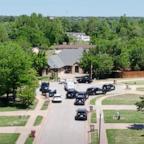New swing states pop up in '08
An Obama, McCain race could blur traditional lines between red and blue states.
WASHINGTON -- The sharp red and blue boundaries that have defined political America for a decade could be blurring.
As Barack Obama moves toward claiming the Democratic presidential nomination, he and presumptive Republican nominee John McCain are devising strategies that challenge long-held assumptions about what states each party targets to reach 270 Electoral College votes, the number needed to win the White House.
Their travel schedules — both were in New Mexico on Monday and Florida last week — are focused on the fall, even as Hillary Rodham Clinton's primary campaign continues. Obama needs fewer than 50 additional delegates to reach 2,026 and clinch the Democratic nomination.
Analysts on both sides have begun calculating the state-by-state matchups between him and McCain.
In some ways, they are a matched pair, each with vulnerabilities in their parties' bases and strength among independents and crossover voters. That makes November a battle between idiosyncratic followers dubbed Obamicans and McCainiacs as well as between traditional Republicans and Democrats.
Among the factors reshaping the battlegrounds: a prospective flood of young voters in the West, growing numbers of Hispanic voters in the Southwest and the serendipity of popular candidates running for the Senate or governorship in Virginia, Oregon and elsewhere. McCain's maverick appeal helps him in New Hampshire and other states with many unaffiliated voters. Obama's likely status as the first African-American nominated for national office boosts him in Southern states with large black populations but creates hurdles in West Virginia and other places where working-class whites are a big part of the electorate.
The new must-have state could be Colorado, a state that's voted Republican in the last three presidential elections but has been moving toward the Democrats. That's one reason the Democratic National Committee chose Denver as the site for its national convention in August.
"Tell me (who wins) Colorado and I will tell you the winner," says Bernadette Budde, a political analyst at BIPAC, a business-oriented political action committee. "The political geography has shifted."
That's for sure. From the 2000 contest to the one in 2004, the Electoral College map was more constant than it had been in any back-to-back presidential races in U.S. history, says political scientist Alan Abramowitz of Emory University. Just three states — Iowa, New Hampshire and New Mexico — backed one party's candidate in one election and the other party's nominee four years later.
"We're not going to see that degree of stability" this time, Abramowitz predicts.
Some swing states will be familiar. "It's very difficult to calculate a Democratic victory without Ohio or Florida or both," Clinton strategist Geoffrey Garin says. A narrow victory in Ohio, the hardest-fought battleground in 2004, gave Bush a second term.
The battle for the Buckeye State will be different this time, though. McCain doesn't have the enthusiastic backing of evangelical Christians who helped Bush win there in 2004, when their turnout was boosted by a ballot measure to ban same-sex marriage. For his part, Obama struggled to connect with working-class whites in the March primary, which Clinton carried.




